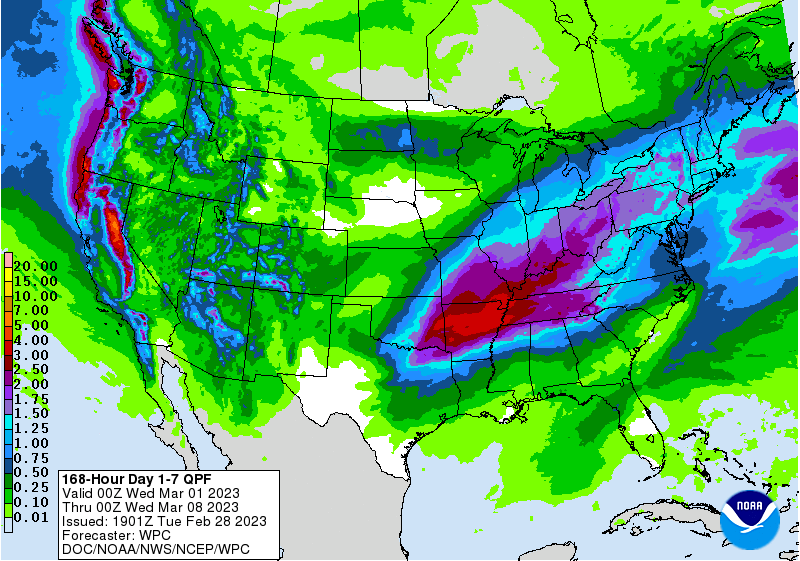
We
heard China’s Sinograin may sell back a million tons of soybeans back to Argentina crushers. Soybean meal and soybeans were under a good amount of pressure today. Soybean oil was lower, but losses limited on higher WTI crude oil. Corn ended sharply lower and
US wheat fell on follow through fund long liquidation. First notice day deliveries were heavier than expected. There were no major changes were seen for SA weather. The morning forecast improved for the US.
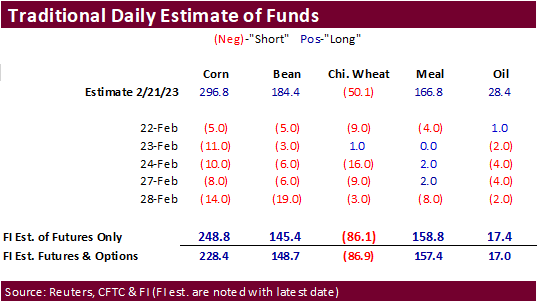
MOST
IMPORTANT WEATHER FOR THE DAY
-
U.S.
Red River Basin of the North is seeing spring flood potentials rise because of additional snow over nearly saturated soil and a deep snowpack -
Spring
flooding will also be possible this year in southwestern Russia and Belarus as well as some neighboring areas due to saturated soil and deep snowpack on top of the wet conditions -
Early
season wheat development has begun in the lower U.S. Midwest, mid-south, southeastern states and far southern Plains due to recent warm temperatures and favorable soil moisture -
Early
season corn and other crop planting has begun in the lower U.S. Delta, South Texas and northeastern Mexico.
-
A
few areas in the far southeastern part of the U.S. may also be in their fields beginning spring planting -
U.S.
dryness remains a concenter in southern Texas, portions of West Texas and in the high Plains of hard red winter wheat country -
No
relief is expected in these areas for at least the next week and possibly for ten days -
Recent
rain and snow in the U.S. central Plains has induced some short term improvement in soil moisture and crop conditions may improve if periodic precipitation continues while seasonal warming evolves
-
Precipitation
Thursday into Friday and again March 8-9 will help maintain and possibly improve the moisture profile in portions of the region -
The
high Plains region need rain more than any other part of the Plains -
U.S.
central and eastern Midwest, Delta and Tennessee River Basin will be the wettest crop areas for a while -
U.S.
rainfall Monday was greatest in the Great lakes region and neighboring areas of the eastern Midwest
-
Rain
totals of 1.00 to 2.00 inches occurred from eastern Wisconsin to northwestern Ohio with amounts surrounding that region getting up to 0.75 inch -
California
coastal areas and much of the northern part of the state received rain and Mountain snow Monday and early today as well
-
California’s
Sierra Nevada will receive another 1.00 to 3.00 inches of moisture today before quieter weather evolves for a little while -
New
snow accumulations will vary from 1 to 3 feet in the Sierra Nevada -
More
storminess may occur briefly next week -
North
America temperatures this week and early next week will be colder than usual in the western parts of both the United States and Canada while temperatures are warmer biased in the Midwest, Delta, southern Plains and Atlantic Coast States -
Some
of the cold in the west will begin spreading to the east in the second week of March including much of the Great Plains and part of the Midwest -
Argentina
will not get enough rain to counter evaporation in the central or south for the next week and possible by nearly ten days -
Greater
rainfall may evolve in the second week of March -
Argentina
was mostly dry Monday and early today -
Far
northern Argentina will experience waves of rain late this week into next week that will improve soil and crop conditions in cotton, dry bean, citrus and sugarcane producing areas from Salta to Formosa and northern Chaco -
Some
minor grain and oilseed areas in the north will also benefit from the moisture, but other areas will be missed by significant precipitation -
Argentina’s
bottom line has not changed much from that of recent days. The bulk of central and southern Argentina will not receive enough rain to counter evaporation or to seriously change crop or field conditions in the next week to nearly ten days. Northern Argentina
crops will experience some improvement with cotton benefiting most from the rain. Some rain will develop in the second week of March, but early indications do not suggest a general soaking and most crop areas will still be looking for a more meaningful rain
to stop the decline in production potentials. -
Routinely
occurring rain is expected in Brazil during the coming ten days to two weeks
-
Bahia,
northeastern Minas Gerais and Espirito Santo will be driest with 0.25 to 0.80 inch and a few amounts to 1.50 inches likely -
Rio
Grande do Sul will receive 1.00 to 2.0 inches of rain while most other areas get 1.00 to 3.00 inches with a few totals to 5.00 inches
-
Wettest
in Parana, Mato Grosso do Sul, Sao Paulo and southern Goias -
Paraguay
rainfall is expected to be significant with some central and northern crop areas getting 2.00 to more than 6.00 inches of rain by the middle part of next week
-
Brazil’s
bottom line is relatively normal for the next two weeks. Fieldwork will be slow in Parana, Paraguay, Mato Grosso do Sul, Sao Paulo and southern Goias due to saturated soil conditions and periodic rainfall. Rio Grande do Sul will get just enough rain to maintain
favorable crop and field conditions, despite early season crop moisture stress. Drying in Bahia and immediate neighboring areas may lead to some crop moisture stress as the region dries out. Mato Grosso fieldwork will advance relatively well over the next
two weeks with planting and harvesting advancing around daily showers and thunderstorms.
-
Europe
precipitation during the weekend was greatest from southern Italy through the Balkan Countries Monday with amounts to 0.60 inch common and a few totals nearing 1.00 inch -
Temperatures
were cooler biased especially in the central and south -
South-central
and southeastern Europe will receive additional precipitation over the next few days while other parts of the continent are dry or mostly dry
-
Moisture
totals through the weekend will vary from 0.20 to 0.75 inch with a few totals reaching up over 1.00 inch
-
Greatest
rain will occur from southern Italy into the eastern Adriatic Sea region where 2.00 to 6.00 inches of rain is likely -
Northern
Europe will not be completely dry, but precipitation amounts will be very light until next week when France and Germany trend wetter -
Temperatures
will also be cooler biased across much of Europe especially in the north through the weekend
-
Europe
should trend warmer in the second week of March -
Western
CIS crop weather will continue wet over the next ten days with waves of snow and rain expected to continue -
Flood
potentials continue to rise for this spring due to saturated soil and significant snow accumulations on top of the ground -
Additional
moisture totals this week will vary from 0.30 to 1.00 inch with a few 1.00- to 2.00-inch totals -
Europe
and Asia temperatures will remain warmer than usual during the coming two weeks except in Western Europe early this week and from Scandinavia through northwestern Russia next week when cooler than usual conditions are likely.
-
India
was mostly dry Monday and that trend will continue for a while -
Some
central India showers will develop lightly in the second week of March, but the precipitation may fall too late and be too light to seriously change winter crop yield potentials -
Far
southern and extreme northern India will get periodic rain over the next two weeks benefiting a few crops, but the majority of the nation will need greater rain to induce the best winter crop yields and quality in unirrigated areas -
Eastern
China precipitation will continue restricted over the next ten days to two weeks except from southern Sichuan to eastern Yunnan where rain will fall periodically to maintain a good environment for crops -
Net
drying is likely in most other areas -
Rain
will have to evolve soon in rapeseed areas to ensure a good start to aggressive crop development -
Wheat
areas have favorable soil moisture and crops are still dormant, but gradual drying is expected through the first half of March -
Eastern
Australia’s dryland cotton, sorghum and other summer crops are unlikely to get much precipitation over the next ten days resulting in additional crop stress and lower production potentials -
Some
rain is expected near the Pacific Coast, but interior areas of Queensland and New South Wales will remain dry -
Irrigated
crops in eastern Australia continue in good condition with normal to above normal yields expected -
Drought
remains a serious concern in the central and interior southwestern Canada Prairies where timely late winter and spring precipitation will be needed this year to support planting and initial crop development.
-
Snow
will fall later this week into next week from western and southern Alberta into southwestern Saskatchewan while precipitation elsewhere will be restricted -
Recent
rain in Philippines lightened after too much rain fell in the previous weekend -
Weather
conditions in the next ten days should be mostly good for the nation -
Indonesia
and Malaysia rainfall will occur abundantly during the next two weeks with all areas impacted and no area experiencing much net drying -
South
Africa rainfall will be restricted for another day or two and then increase late this week through next week
-
The
improved rainfall will maintain a very good summer crop outlook -
West-central
Africa rainfall should increase in the next two weeks -
A
seasonal increase in rainfall is expected to continue gradually over the next two weeks helping coffee, cocoa, rice and sugarcane to begin development normally -
Middle
East precipitation is expected to be erratic and sometimes light over the next couple of weeks raising some need for greater precipitation prior to cotton and rice planting season.
-
Wheat
conditions are rated favorably, but would benefit from additional rain -
Turkey
should be wettest while Syria, Iraq and Jordan need greater rainfall -
Eastern
Africa precipitation will be greatest in Tanzania during the next ten days which is not unusual at this time of year -
Some
rain is expected to develop in Ethiopia, Uganda and Kenya over time, although amounts should be light -
Sunday’s
Southern Oscillation Index was +10.38 and it was expected to move erratically over the next week
Source:
World Weather and FI
Tuesday,
Feb. 28:
- Dubai
Sugar Conference, day 2 - EU
weekly grain, oilseed import and export data - US
agricultural prices paid, received, 3pm - Malaysia’s
Feb. palm oil export data - Vietnam
coffee, rice and rubber export data - EARNINGS:
Golden Agri
Wednesday,
March 1:
- Dubai
Sugar Conference, day 3 - EIA
weekly US ethanol inventories, production, 10:30am - USDA
soybean crush, DDGS production, corn for ethanol, 3pm - Global
Grain and Animal Feed Asia 2023, Singapore, day 1
Thursday,
March 2:
- Dubai
Sugar Conference, day 4 - USDA
weekly net-export sales for corn, soybeans, wheat, cotton, pork and beef, 8:30am - Port
of Rouen data on French grain exports - Global
Grain and Animal Feed Asia 2023, day 2
Friday,
March 3:
- FAO
World Food Price Index, grains report - ICE
Futures Europe weekly commitments of traders report - CFTC
commitments of traders weekly report on positions for various US futures and options, 3:30pm - FranceAgriMer’s
weekly crop conditions reports - Global
Grain and Animal Feed Asia 2023, day 3
Source:
Bloomberg and FI
First
Notice Day
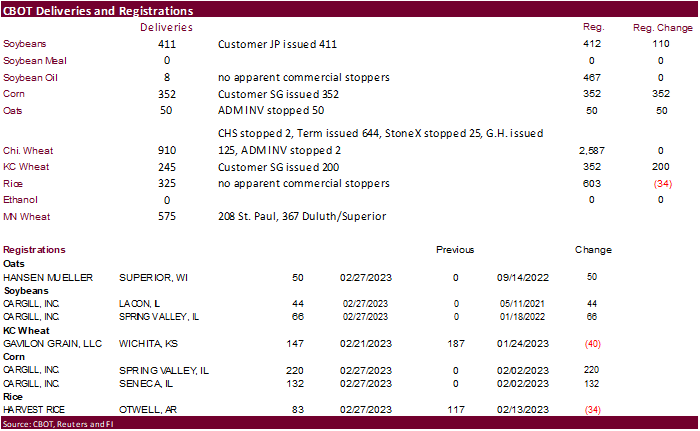
Soybean
and Corn Advisory
2022/23
Argentina Soybean Estimate Lowered 2.0 mt to 32.0 Million
2022/23
Brazil Soybean Estimate Unchanged at 151.0 Million Tons
2022/23
Argentina Corn Estimate Lowered 2.0 mt to 41.0 Million
2022/23
Brazil Corn Estimate Lowered 2.0 mt to 121.0 Million
Macros
Canadian
GDP (Y/Y) Dec: 2.3% (exp 2.7%; prev 2.8%)
GDP
(M/M) Dec: -0.1% (exp 0.0%; prev 0.1%)
Quarterly
Q4 Annualised: 0.0% (exp 1.6%; prevR 2.3%)
US
Advance Goods Trade Balance (USD) Jan: -91.5B (exp -91.0B; prev -90.3B)
US
Wholesale Inventories (M/M) Jan P: -0.4% (exp 0.1%; prev 0.1%)
Retail
Inventories (M/M) Jan: 0.3% (exp 0.1%; prev 0.5%)
US
FHFA House Price Index (M/M) Dec: -0.1% (exp -0.2%; prev -0.1%)
US
S&P CoreLogic CS 20-City (M/M) SA Dec: -0.51% (exp -0.40%; prevR -0.52%)
S&P
CoreLogic CS 20-City (Y/Y) NSA Dec: 4.65% (exp 4.80%; prevR 6.76%)
S&P
CoreLogic CS US HPI (Y/Y) NSA Dec: 5.76% (prevR 7.62%)
US
MNI Chicago PMI Feb: 43.6 (est 45.5; prev 44.3)
US
CB Consumer Confidence Feb: 102.9 (est 108.5; prev 106.0)
–
Present Situation: 152.8 (prev 150.9)
–
Expectations: 69.7 (prev 77.8)
EIA:
US Crude Oil Production Fell 276K Bpd In Dec To 12.101M Bpd
–
Oil Production In Nov Revised Up 2K Bpd To 12.377M Bpd
EIA:
US Crude Oil Exports Fell To 3.853M Bpd In Dec (prev 4.042M Bpd In Nov)
–
Total Refined Oil Product Exports Rose To 3.366M Bpd In Dec (prev 3.088M Bpd In Nov)
107
Counterparties Take $2.188 Tln At Fed Reverse Repo Op. (prev $2.162 Tln, 110 Bids)
·
Corn futures traded
a seven month low from lack of fresh news and improving US weather ahead of planting season.
·
Selected EU countries reported high inflation overnight, renewing concerns over a global economic slowdown.
·
Germany reported another ASF case, this time in the eastern state of Brandenburg, at a small farm.
·
The South African CEC estimated 2023 corn production at 15.615 million tons, up from 15.470 million last season. White was 8.187 million tons and 7.428 million tons of yellow.
·
Ukraine’s southern area of Odesa started 2023 spring plantings.
·
Brazil as expected resumed taxes on gasoline and ethanol at 0.47 real and 0.02 real per liter, respectively.
Export
developments.
-
South
Korea’s NOFI bought an estimated 65,000 tons of feed corn from either the United States or South America for arrival around June 25 at $327.99 a ton c&f.
-
South
Korea’s KFA bought 66,000 tons of feed corn at an estimated $327.99 a ton c&f for arrival around June 5. -
South
Korea’s MFG bought an estimated 64,000 tons of corn, optional origin, at an estimated $328.40 a ton c&f for arrival around June 30.
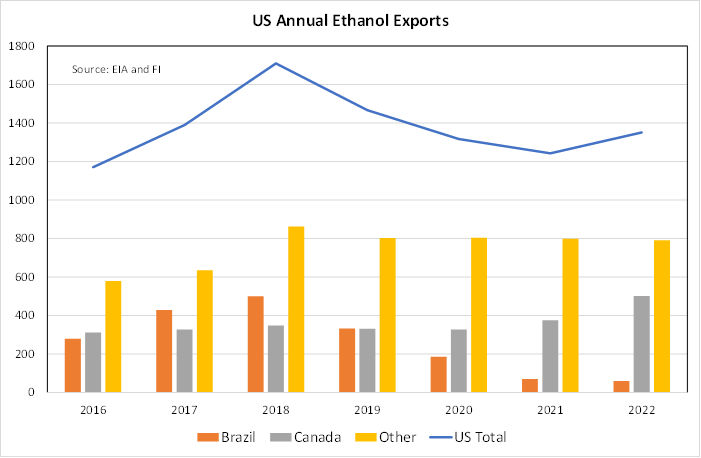
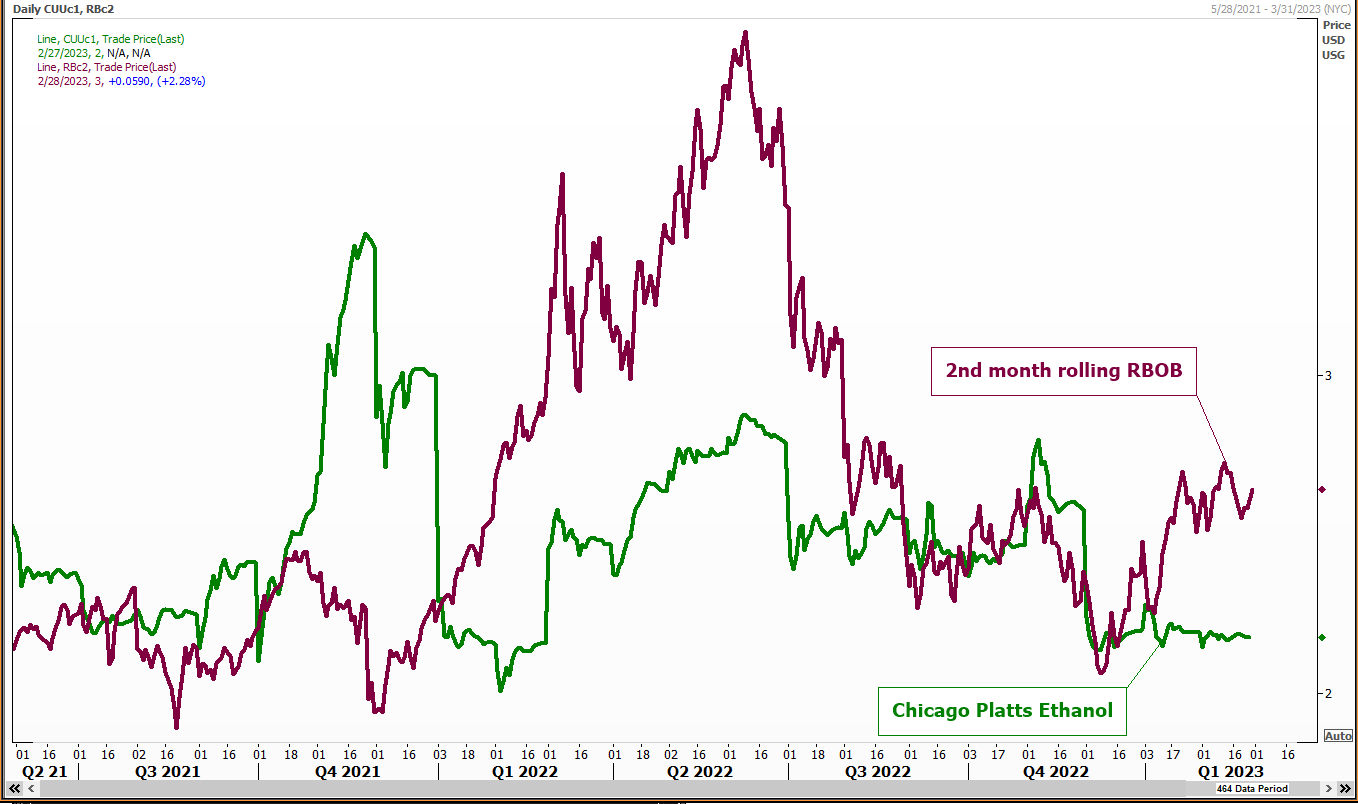
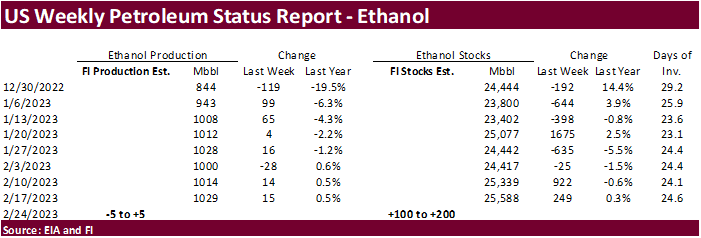

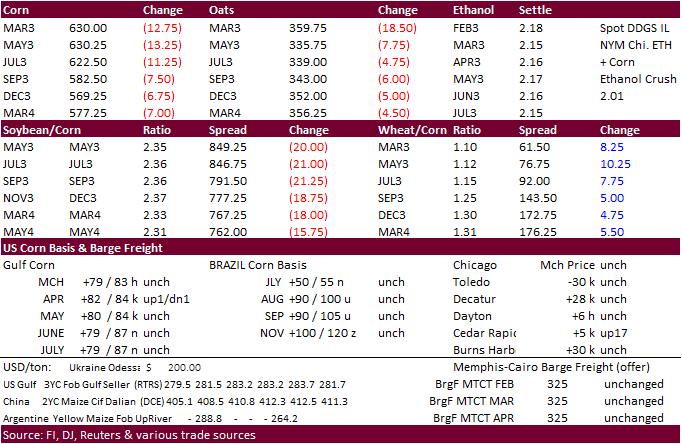
Updated
02/28/23
Soybeans
·
CBOT soybeans, meal and soybean oil traded lower on talk China will sell back soybeans to Argentina, Brazil soybean harvest pressure, heavier than expected deliveries and lower grains. Losses were limited for SBO as WTI crude
oil is seeing a good rebound. During the trade we heard
China may sell back 1.0 million tons of Argentina soybeans they bought earlier to Argentine processors. This would be bearish soybean meal. May soybean meal hits sell stops today at around $476.20.
·
Many indicated soybean meal was overbought, and SA premiums have been falling since last week. Demand destruction was expected to impact that market. Recall the back months of the soybean meal curve are trading at a large discount
to nearby prices.
·
Soybeans traded at a 7-week low. For the month soybeans saw their first monthly decline since September.
·
A Reuters trade estimate calls for the January US soybean crush to be reported at 189.6 million bushels (188.4-191.0 range), up from 187.4 million during December and compares to 194.3 million January 2022. End of February soybean
oil stocks are estimated at 2.349 billion pounds (2.349-2.450 range), up from 2.306 billion at the end of December and compares to 2.500 billion January 2022.
·
Indonesia set its March 1-15 crude palm oil reference price at $889.77 per ton, up slightly from $880.03 per ton Feb. 16-28. Indonesia’s crude palm oil export tax will adjust to $74 per ton and levy at $95 per ton.
·
AmSpec reported Malaysian palm oil exports for the month of February fell 0.4% to 1.062MMT from 1.066MMT during January. ITS reported February palm oil exports up 2.3% to 1.160 million tons from 1.134 million tons.
·
Argentina producers launched a protest this week over taxes, exchange rates and financial support.
Soybean
oil for biodiesel production
was less than expected during the month of December and we lowered our soybean oil for 2022-23 SBO feedstock estimate by 50 million pounds to 11.800 billion, 200 million above USDA.

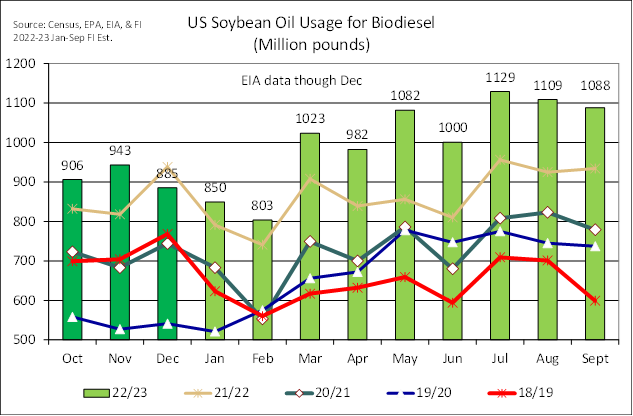
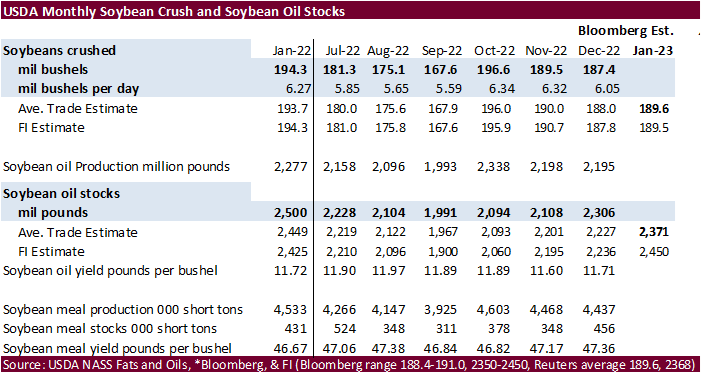
Export
Developments
·
Turkey’s state grain board TMO cancelled their 48,000 ton crude sunflower oil tender. Prices were too high.
·
China auctioned off 32,472 tons of soybean oil from state reserves.
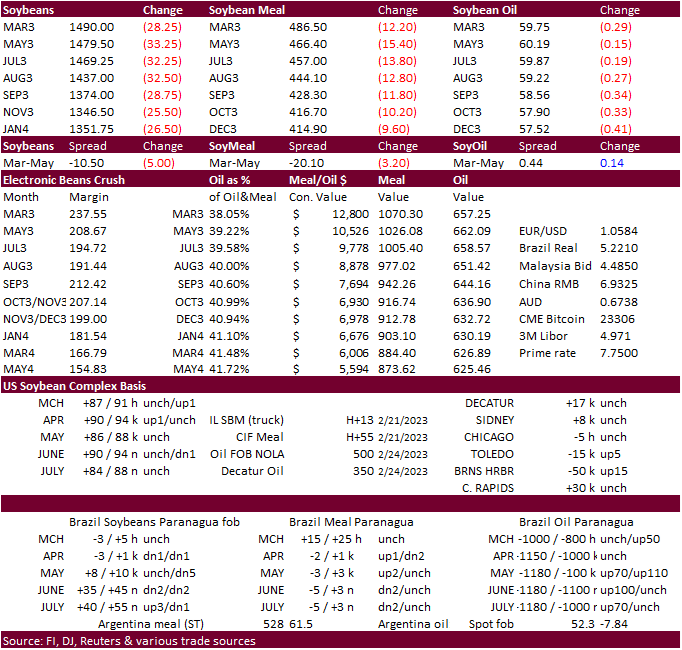
Updated
02/28/23
Soybean
meal – May $430-$490
Wheat
·
US wheat futures traded lower from follow through selling, but some losses were pared from Black Sea shipping concerns. Traders are waiting for news over the Black Sea grain export deal. Ukraine is asking Turkey and the UN to
start talks.
·
Chicago wheat fell five consecutive sessions and trading near a 17-month low.
·
Paris May wheat was down 2.25 euros at 275.75, a per ton, lowest since March.
·
US winter wheat crop conditions for KS decreased 2 points from the previous month to 19% but KS improved to 36% G/E from 17% from January 29 and Texas was up to 19% from 14% previous week (Feb 19). See attached table after text
for major states reported.
Export
Developments.
·
South Korean flour mills bought 85,000 tons of US and Canadian milling wheat. 50,000 tons was sought from the United States and 35,000 tons from Canada, both for shipment between May 1 and May 31.
- US
soft white wheat of about 10% to 11% protein content bought at an estimated $304.96 a ton
- US
soft white wheat of a maximum 8.5% protein bought at $306.06 a ton - US
hard red winter wheat of 11.5% protein bought at $359.53 a ton - US
northern spring/dark northern spring wheat of 14% protein bought at $363.48 a ton - Canadian
western red spring wheat (CWRS) of 13.5% protein bought in the low $340s a ton
·
Jordan’s state grain buyer passed on 120,000 tons of optional origin milling wheat for shipment between Aug. 1-15 and Aug. 16-31.
·
Japan’s AgMin seeks 70,065 tons of food-quality wheat from the United States and Canada later this week.

·
Jordan’s state grain buyer seeks 120,000 tons of optional origin feed barley for shipment between June 1-15, June 16-30, and July 1-15.
·
Taiwan seeks 48,975 tons of US milling wheat on March 1 for PNW shipment between April 19 and May 3. Wheat types sought include dark northern spring, hard red winter and white wheat.
·
Turkey seeks 440,000 tons of feed barley on March 2.
Rice/Other
·
None reported
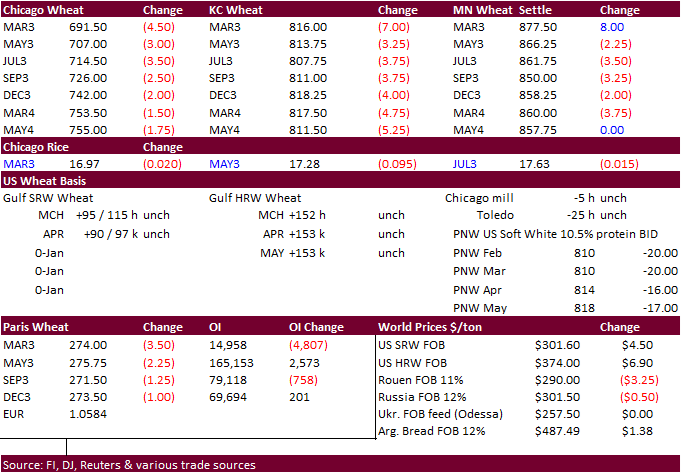
Updated
02/28/23
KC
– May $7.50-$9.25
MN
– May
$8.00-$10.00
| Terry Reilly Senior Commodity Analyst – Grain and Oilseeds |
| Futures International One Lincoln Center 18W140 Butterfield Rd. Suite 1450 Oakbrook terrace, Il. 60181 |
| Work: 312.604.1366 ICE IM: treilly1 Skype IM: fi.treilly |
| treilly@futures-int.com
|
| DISCLAIMER: The contents of this communication and any attachments are for informational purposes only and under no circumstances should they be construed as an offer to buy or sell, or a solicitation to buy or sell any future, option, swap or other derivative. The sources for the information and any opinions in this communication are believed to be reliable, but Futures International, LLC does not warrant or guarantee the accuracy of such information or opinions. This communication may contain links to third party websites which are not under the control of FI and FI is not responsible for their content. Trading of futures, options, swaps and other derivatives is risky and is not suitable for all persons. All of these investment products are leveraged, and you can lose more than your initial deposit. Each investment product is offered only to and from jurisdictions where solicitation and sale are lawful, and in accordance with applicable laws and regulations in such jurisdiction. The information provided here should not be relied upon as a substitute for independent research before making your investment decisions. Futures International, LLC is merely providing this information for your general information and the information does not take into account any particular individual’s investment objectives, financial situation, or needs. All investors should obtain advice based on their unique situation before making any investment decision. Futures International, LLC and its principals and employees may take positions different from any positions described in this communication. Past results are not necessarily indicative of future results. |

